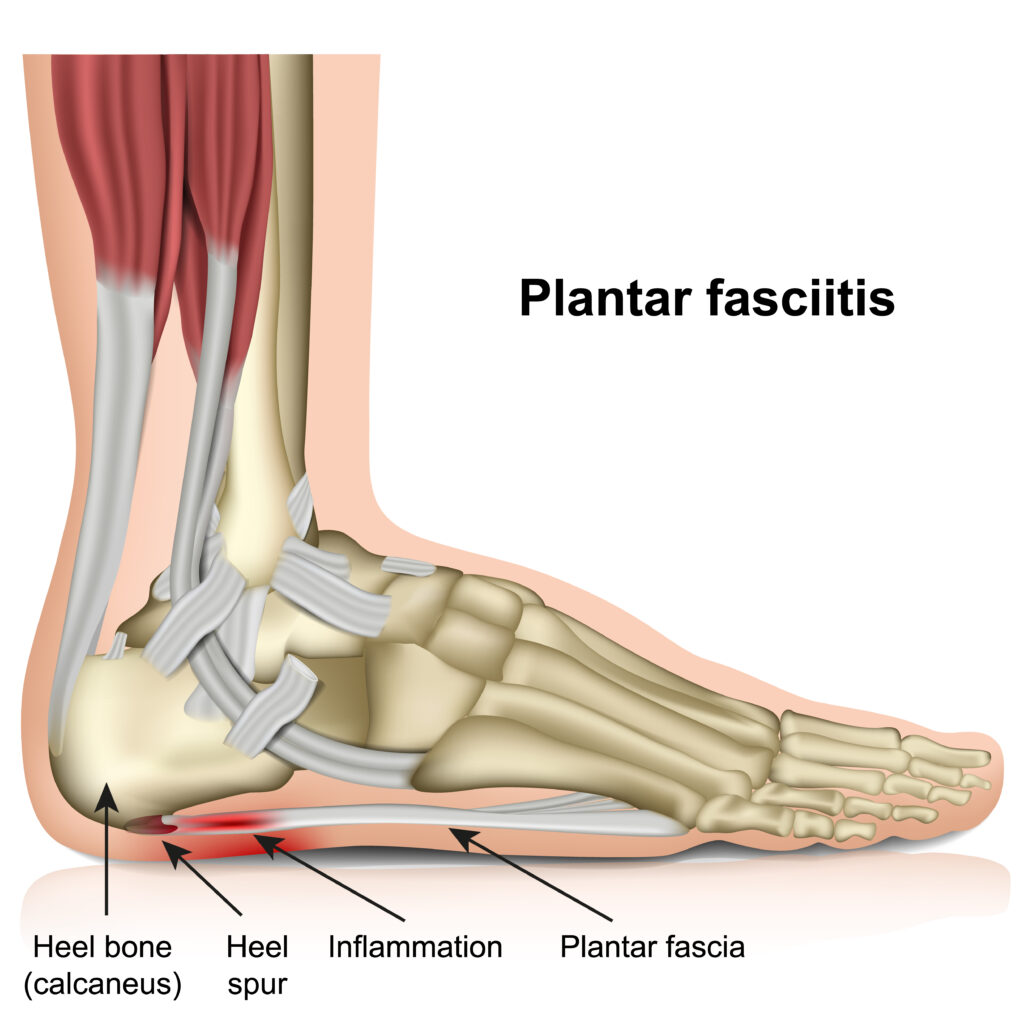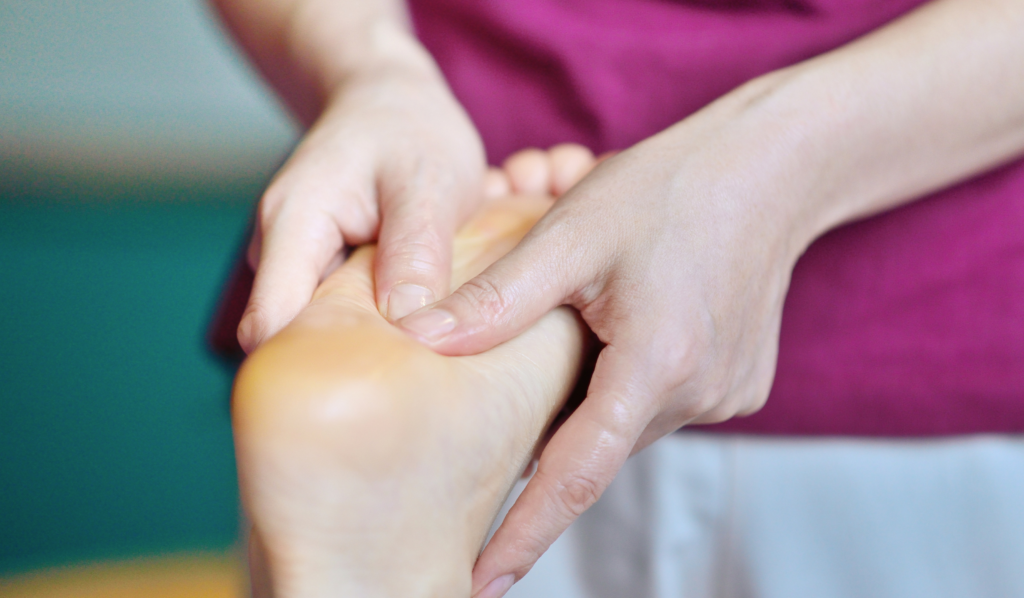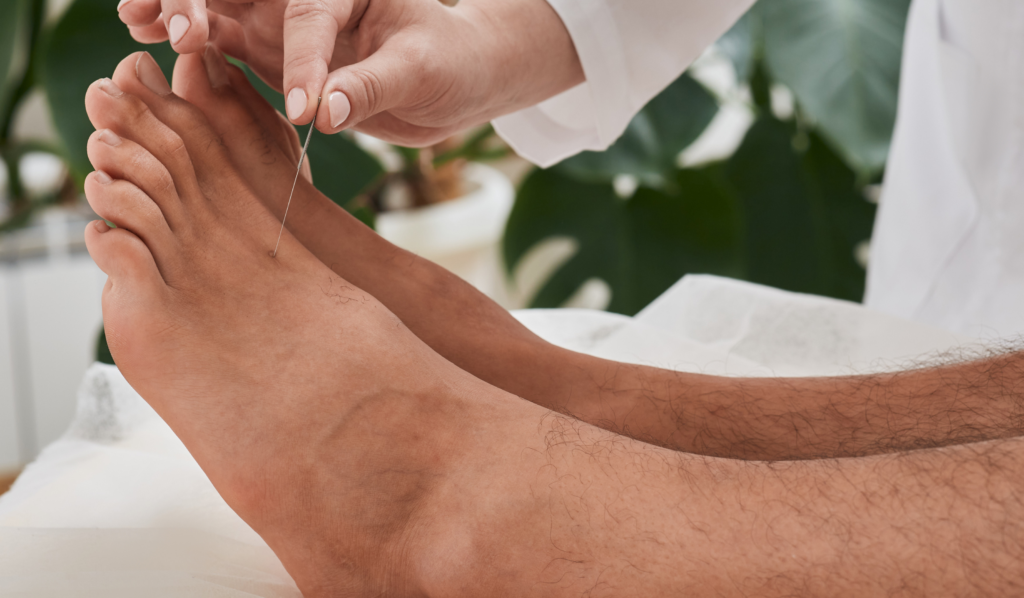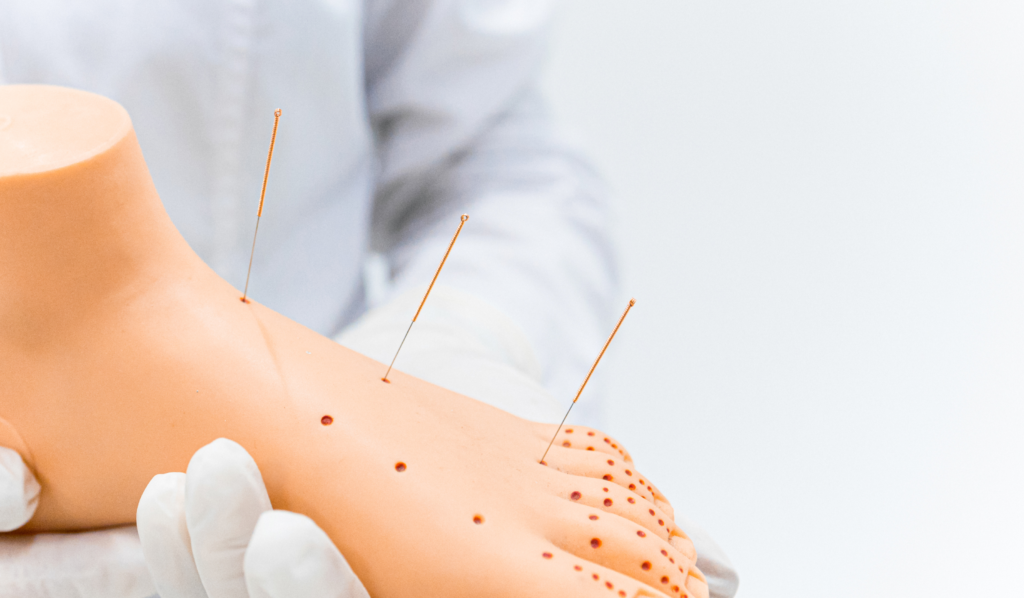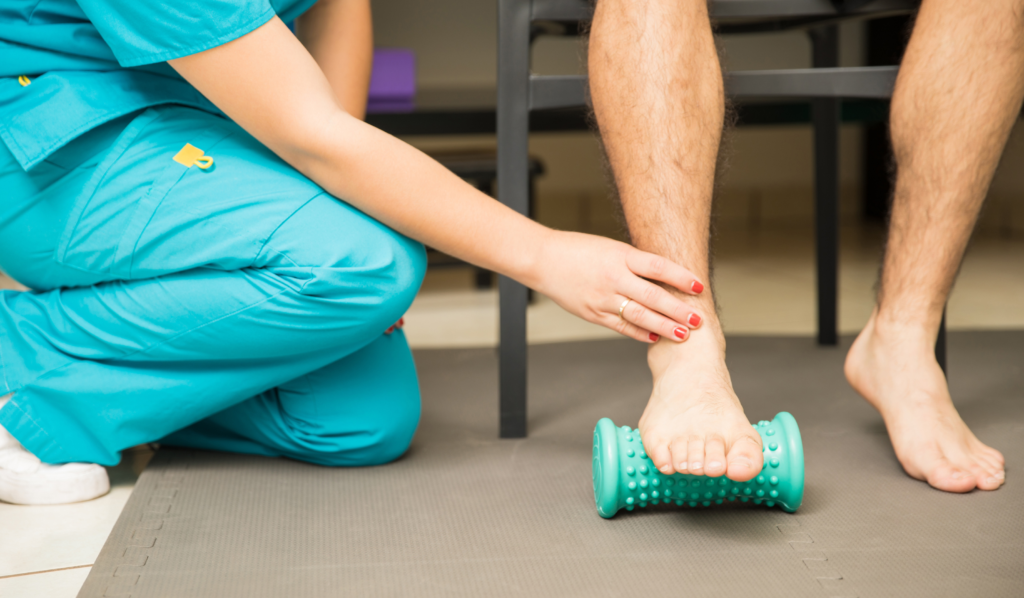Acupuncture for Plantar Fasciitis: A Natural Solution for Foot Pain Relief
Plantar fasciitis is one of the most common causes of heel pain, affecting runners, athletes, and individuals who spend long hours on their feet. The sharp, stabbing pain in the heel—often worst in the morning—can make even simple activities like walking or standing a struggle. While treatments such as stretching, orthotics, and pain medications provide relief for some, many people continue to experience persistent discomfort.
Acupuncture has emerged as a natural, effective alternative for plantar fasciitis, offering relief by reducing inflammation, relaxing tense muscles, and promoting healing. By targeting specific acupuncture points, this traditional Chinese medicine (TCM) approach can help patients regain mobility and comfort without the side effects of medication or the invasiveness of surgery.
Understanding Plantar Fasciitis
What Is Plantar Fasciitis?
Plantar fasciitis is the inflammation of the plantar fascia, a thick band of tissue that runs along the bottom of the foot, connecting the heel bone to the toes. This tissue acts as a natural shock absorber, supporting the arch of the foot and helping distribute weight evenly while walking, running, or standing. However, when excessive stress is placed on the plantar fascia, small tears can develop, leading to irritation, inflammation, and pain.
This condition is particularly common among athletes, individuals with jobs that require long hours of standing, and those with biomechanical foot imbalances. The pain is often most noticeable in the morning after waking up, as the plantar fascia tightens overnight and is suddenly stretched when weight is placed on the foot. Many people experience discomfort when taking their first steps after rest, but the pain may lessen as the tissue warms up. However, without proper treatment, the condition can become chronic and progressively worsen over time, affecting overall mobility and quality of life.
Causes of Plantar Fasciitis
Overuse and Repetitive Stress
Constant strain on the plantar fascia from activities like running, dancing, or standing for long hours can lead to tiny tears in the tissue. Over time, these micro-tears cause inflammation and result in chronic pain, especially in those who don’t allow proper recovery.
Tight Calf Muscles and Achilles Tendon
When the muscles in the calf or the Achilles tendon are too tight, they pull on the plantar fascia and increase tension in the foot. This added stress makes the tissue more vulnerable to inflammation and discomfort, limiting mobility and making daily movements painful.
Sudden Increase in Activity Level
A drastic change in physical activity, such as increasing running distance too quickly or switching to high-impact workouts, can overload the plantar fascia. Without proper conditioning, the tissue struggles to absorb shock, resulting in irritation and pain.
Improper Footwear
Wearing shoes with poor arch support, hard soles, or excessive wear can force the plantar fascia to absorb more pressure than it should. Over time, this can cause irritation, inflammation, and long-term foot discomfort.
Biomechanical Issues
Foot structure plays a major role in plantar fasciitis. Those with flat feet, high arches, or an irregular walking gait may put uneven pressure on their plantar fascia, leading to excessive strain and an increased risk of developing pain.
Common Symptoms of Plantar Fasciitis
- Sharp, stabbing heel pain that is often most intense in the morning or after periods of inactivity. Many people describe it as feeling like a knife is stabbing their heel when they take their first steps out of bed.
- Discomfort that worsens after prolonged standing or walking but may improve temporarily with movement. As the day progresses, pain may return due to continuous strain on the foot.
- Tightness in the arch of the foot, making it difficult to flex or stretch without pain. The arch may feel stiff, causing discomfort when pointing the toes or rolling the foot.
- Swelling or tenderness around the heel, especially after physical activity. Inflammation can make the area sensitive to touch, and in severe cases, redness and warmth may develop.
- Pain that radiates from the heel to the arch or up the calf. The discomfort can spread as other muscles and tendons compensate for the strained plantar fascia.
- Increased stiffness after periods of rest. Pain tends to be worse after sitting for long periods, requiring time for the foot to adjust before walking comfortably.
- Burning or aching sensation in the sole of the foot. Some individuals experience a deep, persistent ache that worsens with activity.
- Reduced range of motion and difficulty bearing weight. Severe cases may make it challenging to walk long distances, stand for extended periods, or engage in physical activities without discomfort.
Risk Factors for Plantar Fasciitis
High-impact activities such as running, dancing, and jumping put extreme stress on the plantar fascia. The repeated pressure from these activities can cause micro-tears in the tissue, leading to inflammation and persistent pain. Athletes and fitness enthusiasts are particularly susceptible to developing plantar fasciitis if they do not incorporate adequate stretching and recovery.
Improper footwear and lack of arch support can increase strain on the foot’s connective tissue. Wearing shoes with inadequate cushioning or worn-out soles forces the plantar fascia to absorb excessive impact, making it prone to irritation and injury. Investing in well-structured footwear with proper arch support can significantly reduce the risk of plantar fasciitis.
Foot structure abnormalities, including flat feet or high arches, affect how weight is distributed. People with these conditions may place uneven pressure on their plantar fascia, increasing the likelihood of overuse injuries. Custom orthotics or supportive insoles can help balance weight distribution and prevent excessive strain.
Obesity or excessive weight-bearing places additional stress on the foot with every step. Carrying extra weight increases the load on the plantar fascia, making it more prone to inflammation. Weight management and strengthening exercises for the lower extremities can help reduce stress on the feet.
Long hours of standing on hard surfaces without adequate foot support can increase inflammation over time. Jobs that require prolonged standing, such as retail work, teaching, or factory labor, can contribute to plantar fasciitis. Using anti-fatigue mats and wearing supportive footwear can help alleviate the pressure on the feet.
How Acupuncture Helps with Plantar Fasciitis
Acupuncture’s Role in Pain Management
Acupuncture works by stimulating specific points in the body to enhance circulation, reduce inflammation, and restore balance. For plantar fasciitis, acupuncture can:
- Block pain signals to the brain, reducing discomfort without medication.
- Trigger the release of endorphins, the body’s natural pain-relieving hormones.
- Improve blood circulation to the foot, promoting tissue repair.
- Relax tight muscles and fascia, increasing flexibility and reducing strain on the foot.
Acupuncture Points for Plantar Fasciitis
- Kidney 1 (Yongquan) – Located on the sole of the foot, this point helps relieve heel pain and stimulates energy flow.
- Bladder 60 (Kunlun) – Found near the Achilles tendon, this point eases tension and encourages blood flow.
- Spleen 6 (Sanyinjiao) – Strengthens the lower leg muscles that provide essential support for the arch.
- Liver 3 (Taichong) – Reduces inflammation and tension in the foot and lower leg, making movement more comfortable.
- Local Points – Needles are placed around the plantar fascia and heel to directly target pain and inflammation.
Why Traditional Treatments Sometimes Fall Short
Many people turn to NSAIDs, cortisone injections, stretching, and orthotics to manage their plantar fasciitis. While these treatments may provide temporary relief, they often fail to address the underlying inflammation and muscle tightness. Surgery is sometimes recommended for severe cases, but it comes with risks and a long recovery time. Acupuncture, on the other hand, offers a non-invasive, long-term solution that promotes natural healing without side effects.
Other Treatments for Plantar Fasciitis
While acupuncture is an effective treatment for plantar fasciitis, other conventional and alternative therapies are also commonly used. The best approach often involves a combination of treatments tailored to the individual’s needs.
Physical Therapy
Physical therapy focuses on stretching and strengthening exercises to improve foot flexibility and reduce strain on the plantar fascia. Therapists may use techniques such as manual therapy, ultrasound therapy, and shockwave therapy to promote healing and relieve pain.
Orthotic Supports and Proper Footwear
Wearing supportive shoes with proper arch support and cushioned soles can alleviate stress on the plantar fascia. Custom orthotics or over-the-counter insoles help distribute weight evenly and provide additional shock absorption.
Medication and Injections
Nonsteroidal anti-inflammatory drugs (NSAIDs), such as ibuprofen or naproxen, can help reduce inflammation and provide temporary pain relief. For more severe cases, corticosteroid injections may be administered to reduce inflammation and alleviate discomfort, although repeated use can weaken the plantar fascia over time.
Extracorporeal Shockwave Therapy (ESWT)
This non-invasive treatment uses sound waves to stimulate healing in the plantar fascia. ESWT has been shown to reduce pain and promote tissue regeneration, making it a viable option for those who have not responded to other treatments.
Night Splints and Taping
Night splints help keep the foot in a stretched position while sleeping, preventing the plantar fascia from tightening overnight. Taping techniques, such as kinesiology taping, can provide temporary relief by supporting the arch and reducing tension on the fascia.
Surgery (For Severe Cases)
If conservative treatments fail, surgery may be considered. Plantar fasciotomy involves partially cutting the plantar fascia to relieve tension and reduce pain. However, surgery is typically a last resort due to the risks and lengthy recovery time involved.
Each treatment option comes with its own benefits and risks, so it is essential to work with a healthcare professional to determine the best plan for managing plantar fasciitis effectively.
Finding Lasting Relief with Acupuncture
Plantar fasciitis can be frustrating and debilitating, but acupuncture provides a safe, effective, and holistic approach to pain relief. By improving circulation, reducing inflammation, and promoting natural healing, acupuncture allows individuals to regain mobility without relying on invasive treatments.
If you are struggling with persistent heel pain, our practitioners at ACA Acupuncture and Wellness can develop a personalized acupuncture treatment plan to help you heal and stay pain-free.
Sources:
Thiagarajah, A. G. (2017). How effective is acupuncture for reducing pain due to plantar fasciitis? Journal of Pain Research, 10, 951–954.
Shi, J., Jiao, R., Liu, Y., Liu, X., Sun, Y., Shi, H., Gao, N., Liu, Z., Liang, J., & Wang, W. (2024). Comparing different session regimens of electroacupuncture for chronic plantar fasciitis: Study protocol for a randomized clinical trial. Journal of Traditional Chinese Medicine, 44(2), 100–110.
Frequently Asked Questions
Can acupuncture help plantar fasciitis?
Yes, acupuncture is an effective treatment for plantar fasciitis. By stimulating specific acupuncture points, it helps reduce inflammation, relieve pain, and improve circulation in the affected foot. Many patients experience significant relief after just a few sessions.
How many acupuncture sessions are needed for plantar fasciitis?
The number of sessions varies depending on the severity of the condition. Most patients start noticing improvement within 3 to 5 sessions, but chronic cases may require 8 to 12 sessions for lasting results. A licensed acupuncturist can develop a personalized treatment plan based on your symptoms.
Does acupuncture provide long-term relief for plantar fasciitis?
Yes, acupuncture not only alleviates pain but also promotes natural healing by increasing blood flow and reducing muscle tension. When combined with lifestyle adjustments, such as stretching and wearing supportive footwear, acupuncture can provide long-term relief.
Is acupuncture for plantar fasciitis painful?
Acupuncture is generally not painful. The needles used are extremely thin, and most people experience only a mild tingling or warmth at the insertion points. Many patients find the treatment relaxing and report feeling relief during and after the session.
How does acupuncture compare to other treatments for plantar fasciitis?
Unlike medication, which only masks symptoms, acupuncture addresses the root cause by improving circulation and reducing inflammation. Compared to corticosteroid injections, acupuncture has no side effects and offers a natural healing approach without the risk of tissue weakening. It also complements physical therapy and orthotic support.
How soon can I expect relief after acupuncture?
Some patients experience immediate relief after their first session, while others notice a gradual improvement over several treatments. The healing process varies, but consistency is key to long-term results.
Are there any side effects of acupuncture for plantar fasciitis?
Acupuncture is a safe, non-invasive treatment with minimal side effects. Some people may experience slight bruising or mild soreness at needle insertion points, but these effects are temporary and subside quickly.
Contact ACA Acupuncture & Wellness
Get in Touch
Newsletter Sign Up

ACA Franchise Opportunities
The over $4 billion US acupuncture market offers a great opportunity with over 10% annual growth rates and a continuing flow of new patients interested in the benefits of acupuncture.


